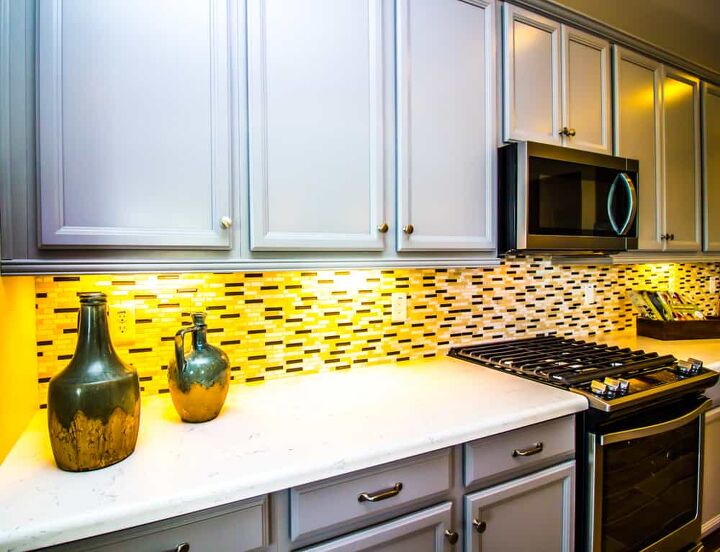How To Hide Under Cabinet Lighting Wires (5 Ways To Do It!)

The kitchen is the heart of many homes, and every single detail determines the overall look of the space. Everything from flooring, countertops, cabinets, and lighting is crucial to an attractive kitchen. Under-cabinet lighting can add value to a home, but it can be frustrating when you can’t hide the wires.
You can hide under cabinet wiring with valances, cable protectors, or if you install a panel. Otherwise, you can modify the cabinet so that you can place the wires inside of the cabinet without hanging out. You can also secure the wires under the cabinet using brackets.
Under-cabinet lighting is gorgeous, and wires that hang down can seriously detract from them. Between wooden valances, cable protectors, and special panels, there are many options to hide lighting wires. Follow along as we explore everything that you can do to hide your under-cabinet lighting wires.
Do You Need to Hire an Electrician?
Get free, zero-commitment quotes from pro contractors near you.

Valances
Wooden valances are an excellent way to hide under cabinet lighting wires, and they look great. You can find valances of all shapes, sizes, and colors that can match your cabinets and kitchen overall. All that you need to attach a valance to your cabinet to hide wires is some wood glue.
The wooden valance essentially acts as an extension of your cabinet, and it will cover the wires. You can paint the valance to match the cabinets and your kitchen if you are unable to find one that matches. It wouldn’t hurt to use brackets on the inside of the valance so that you can fasten the wires to them.
Staples also work, and they can help the wires from hanging down and disrupting the room’s aesthetic. Simply attach the valance to the cabinet with wood glue, allow it to dry, and staple or bracket the wires in place. You won’t be able to spot the wires, and the valance will help to compliment and accentuate your cabinets.
Inside the Cabinet
Tucking the wires inside the cabinet often requires that you plan during the installation of your cabinets. Oftentimes, builder-owners and renovators will cut a hole in the bottom of the cabinets to snake the wires through. This option is the most ironclad because you won’t have to deal with the wires sagging or drooping down.
If your wires cabinets and lighting is already installed, you can cut into the cabinet to make it possible to hide the wires. Under-cabinet lighting is often installed through the back of the cabinet, and that will make it easier to hide the wires. You can cut directly into the wall to tuck the wires inside if you are a seasoned builder-owner or DIY enthusiast.
You can then place wooden planks over the hole that you cut in the wall, cut a hole in the plank, and feed the wires through. That way, you won’t have to worry about a gaping hole in the wall and your wires won’t be left exposed.
Install a Panel
Another easy way to hider under-cabinet lighting wires is by simply installing another panel on the bottom. You can either purchase the same wood as the cabinets or buy the wood of your choice and paint it to match.
Step 1. Cut the Panel
Cut a wooden panel to the exact measurement of the underside of the cabinets before installing. For this project, there is no benefit between a miter saw and a circular saw, but you can get by with a table saw. Gather protective gear, such as goggles, a face mask, and gloves, then mark the wood panel according to the cabinet measurements.
Step 2. Hole For Wires
Next, take a look inside of or underneath the cabinet to see where the wires hang down. Use chalk or a marker to signify where the wires will come out to reach and power the lights. Mark the panel where there’s enough space for the wires to run to the lights without drooping down or sagging.
Step 3. Cut a Hole In the Panel
Now, you can cut a hole in the panel to coordinate with the wires using a rotary saw. Make the hole big enough to comfortably fit the wires through without being so big that they flop out. Refer to the markings that you made in the previous step.
Step 4. Install the Panel
Once you’ve prepared the panel, you can carefully place it underneath the cabinet and nail it in place. Gently pull the wires to make sure that they fit properly with the new panel. Place brackets on the wires so that they stay inside the cabinet with your new panel, and they are properly hidden.
Once the panel is installed, you can paint it to match the cabinets if you haven’t already. Otherwise, you can find a wooden panel that already matches your cabinets.
Cable Protector
Cable protectors are possibly the simplest way that you can hide your under-cabinet lighting wires. You can hide the wires in your under-cabinet lighting for less than $60 in most cases. Simply bundle up the wires so that they’re close together and straight and run them into a cable protector.
Cable protectors can be made of wood, plastic, or more, but wood is the best option for cabinets. You can place a bracket or two on the wires before you put them in the cable protector so they’re tight. A small rotary saw or router is perfect for cutting a small hole in the cable protector to fit the wires inside.
You can choose to paint the cable protector if you’re worried about it clashing with the cabinets. The cable protector can be fastened to the cabinet with wood glue or you can nail it in. However, if you nail the cable protector to the cabinet, make sure that you’re not hammering into wires.
Related Questions
Does under cabinet lighting add value?
Yes, under-cabinet lighting does add value to a home, and it’s a simple way to do so. The kitchen itself is one of the biggest selling points in a home, and alteration of any kind can add value. Under-cabinet lighting helps to accentuate countertops, flooring, and the cabinets themselves which all add value.
How far apart should under cabinet lighting be?
You should generally space out under-cabinet lighting by at least 8”-12” underneath the cabinet. Spacing them out any further than that fails to illuminate countertops and flooring the same way that it would. Under-cabinet lights look great close together when you have a backsplash, granite countertops, or reflective surfaces in the kitchen.
How far should recessed lights be from cabinets?
You want at least between one foot and 18” of space between recessed lights and the cabinets. If they were too close to the cabinets, they wouldn’t be able to shine on the countertops as well. Depending on how far your cabinets stick out, you can place the recessed lights even further away from the cabinets.
What is the best type of under cabinet lighting?
Now, LED lights are considered the best type of under cabinet lighting due to energy efficiency. Besides being energy-efficient, LED lights are long-lasting and bright enough to illuminate the kitchen well. Fluorescent lights are a good option as well, but they’ll run your energy bills higher and won’t last nearly as long as LEDs.
Is under cabinet lighting expensive?
Under-cabinet lighting can be expensive if you have multiple fixtures as each can cost over $250. The materials and lights themselves are inexpensive, but labor can make the cost soar. You could install your under-cabinet lighting for less than $40 per fixture.
Does recessed lighting use more electricity?
Recessed lighting only uses more electricity if you use options like fluorescent lights. However, LED lights are energy-efficient and can consume 80% less electricity than fluorescent. Incandescent bulbs are also less energy-efficient than LEDs and will make for higher energy bills.
Do You Need to Hire an Electrician?
Get free, zero-commitment quotes from pro contractors near you.

Summing It Up
The quickest way to hide under-cabinet lighting is by running it through a cable protector and securing it with staples. Otherwise, you could purchase a wooden valance and pin the wires to it with a staple or bracket. This option is great because you can stain or paint the wooden valance so that it matches your cabinets.
If you plan in your cabinet design, you can make it so that the wires sit inside the cabinet. Otherwise, you can create a new bottom panel to add to the bottom of your cabinet to hide the walls. In this method, you’ll need to cut holes in the panel to run the wires through and fasten them with a bracket.
You can also cut a hole in the bottom of the cabinet, pull the wires through, and attach them to the inside of the cabinet. The easiest option is to just purchase cable protectors, which will cost you less than $60, but each option works. Your under-cabinet lighting will add value to your home, especially if you can keep those wires hidden.

Nick Durante is a professional writer with a primary focus on home improvement. When he is not writing about home improvement or taking on projects around the house, he likes to read and create art. He is always looking towards the newest trends in home improvement.
More by Nick Durante












![10 Best Electric Pressure Washers – [2022 Reviews & Guide]](https://cdn-fastly.upgradedhome.com/media/2023/07/31/9070600/10-best-electric-pressure-washers-2022-reviews-guide.jpg?size=350x220)

![The 5 Best Angle Grinders – [2022 Reviews & Buyer's Guide]](https://cdn-fastly.upgradedhome.com/media/2023/07/31/9071326/the-5-best-angle-grinders-2022-reviews-buyer-s-guide.jpg?size=350x220)



![Cost To Drill A Well [Pricing Per Foot & Cost By State]](https://cdn-fastly.upgradedhome.com/media/2023/07/31/9074980/cost-to-drill-a-well-pricing-per-foot-cost-by-state.jpg?size=350x220)








